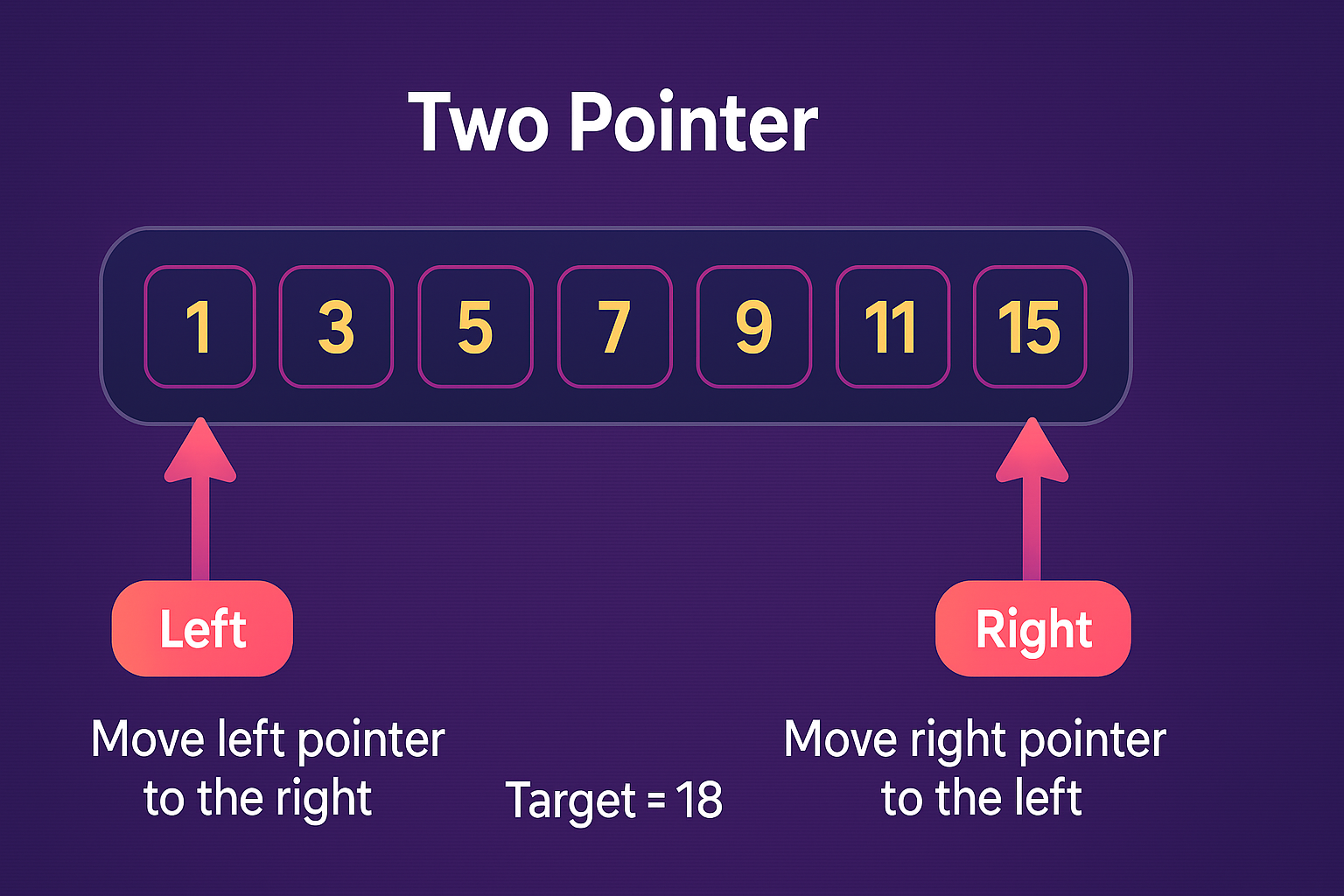Mastering Two Pointers: Solve Array Problems Faster
 Nisha Kataria
Nisha Kataria
An Introduction to the Two Pointer Technique: The Two Pointer technique is a fundamental algorithmic approach used in solving array and string problems efficiently. It involves maintaining two indices (pointers) that traverse the array from different directions or in a specific manner to solve problems in O(N) time complexity instead of O(N²) for brute force solutions.
Why Do we use the Two Pointer Technique?
Optimized Performance: It reduces O(N²) complexity (brute force) to O(N) or O(N Log N) in many Cases.
Efficient for Sorted Arrays: Many Problems involving sorted arrays or lists can be solved efficiently with two pointers.
Reduces Space Complexity: In most cases, It requires O(1) extra space.
Simple to Implement: It makes complex problems easier to understand and solve.
Types Of Two Pointer Approaches
Opposite Direction (Two Ends)
Used When -
→ The array is Sorted.
→ We need to find pairs that satisfy the conditions (e.g., sum of two numbers).
→ We need to check for symmetry (e.g. palindrome checking).
🔠 Example: Two Sum in a Sorted Array.Problem: Given a sorted array, find two numbers that add up to a target sum.
Visualization:
Array: [1, 3, 5, 7, 10, 15] Target = 12
| Left Pointer (L) | Right Pointer (R) | Sum (
arr[L] + arr[R]) | Action | | --- | --- | --- | --- | | 1 (index 0) | 15 (index 5) | 1 + 15 = 16 | Sum > Target → MoveRleft | | 1 (index 0) | 10 (index 4) | 1 + 10 = 11 | Sum < Target → MoveLright | | 3 (index 1) | 10 (index 4) | 3 + 10 = 13 | Sum > Target → MoveRleft | | 3 (index 1) | 7 (index 3) | 3 + 7 = 10 | Sum < Target → MoveLright | | 5 (index 2) | 7 (index 3) | 5 + 7 = 12 | Pair Found → (5, 7) ✅ |Result:
Pair
(5,7)forms the target sum12.JavaScript:
function twoSumOpposite(arr, target) { let left = 0, right = arr.length - 1; while (left < right) { sum = arr[left] + arr[right]; if (sum === target) { return [arr[left], arr[right]]; } else if (sum < target) { left++; } else { right--; } } return []; } let arr = [1, 2, 3, 4, 6], target = 9; console.log(twoSumOpposite(arr, target));✅ Time Complexity: O(N)
Same Direction (Sliding Window)
Used When -
→ Finding Subarrays with a condition.
→ Finding Longest/Shortest Substrings with unique properties.
→When dealing with strings or continuous arrays.
📌 Example : Longest Substring Without Repeating Characters
Problem: Find the length of the longest substring without repeating characters.
Example:
"abcabcbb"✅ Output:
3("abc")Index (
end)| | Char |
start|charIndex(last seen index) | Substring | Length (maxLength) | | --- | --- | --- | --- | --- | --- | | 0 | a | 0 | {a: 0} | "a" | 1 | | 1 | b | 0 | {a: 0, b: 1} | "ab" | 2 | | 2 | c | 0 | {a: 0, b: 1, c: 2} | "abc" | 3 | | 3 | a | 1 | {a: 3, b: 1, c: 2} | "bca" | 3 | | 4 | b | 2 | {a: 3, b: 4, c: 2} | "cab" | 3 | | 5 | c | 3 | {a: 3, b: 4, c: 5} | "abc" | 3 | | 6 | b | 5 | {a: 3, b: 6, c: 5} | "cb" | 3 | | 7 | b | 7 | {a: 3, b: 7, c: 5} | "b" | 3 |JavaScript
let s = 'abcabcbb'; let charSet = new Set(); let left = 0, maxLength = 0; for (let right = 0; right < s.length; right++) { while (charSet.has(s[right])) { charSet.delete(s[left]); left++; } charSet.add(s[right]); maxLength = Math.max(maxLength, right - left + 1); } console.log(maxLength);✅ Time Complexity: O(N)
Two Pointers on Different Arrays
→ Merging two sorted arrays.
→ Finding intersections between two sorted arrays.
Example 3: Merge Two Sorted Arrays
Problem: Given two sorted arrays, merge them into one sorted array.
🔢 Example:
arr1 = [1, 3, 5],arr2 = [2, 4, 6]
✅ Output:[1, 2, 3, 4, 5, 6]| Step | i | j | arr1[i] | arr2[j] | Result | | --- | --- | --- | --- | --- | --- | | 1 | 0 | 0 | 1 | 2 | [1] | | 2 | 1 | 0 | 3 | 2 | [1, 2] | | 3 | 1 | 1 | 3 | 4 | [1, 2, 3] | | 4 | 2 | 1 | 5 | 4 | [1, 2, 3, 4] | | 5 | 2 | 2 | 5 | 6 | [1, 2, 3, 4, 5] | | 6 | 3 | 2 | X | 6 | [1, 2, 3, 4, 5, 6] |
✅ Final Merged Array:
[1, 2, 3, 4, 5, 6]JavaScript
function mergeTwoDifferentArrays(arr1, arr2) { let i = 0, j = 0; let mergeArray = []; while (i < arr1.length && j < arr2.length) { if (arr1[i] < arr2[j]) { mergeArray.push(arr1[i]); i++; } else { mergeArray.push(arr2[j]); j++ } } while (i < arr1.length) { mergeArray.push(arr1[i]); i++; } while (j < arr2.length) { mergeArray.push(arr2[j]); j++ } return mergeArray; } console.log(mergeTwoDifferentArrays([1, 3, 5], [2, 4, 6]))✅ Time Complexity: O(n + m)
🚀 Conclusion: Two Pointer Technique Summary
The Two Pointer technique is a powerful optimization strategy that reduces time complexity from O(N²) to O(N) in many cases. It is widely used in arrays, strings, and linked lists for solving problems efficiently.
Subscribe to my newsletter
Read articles from Nisha Kataria directly inside your inbox. Subscribe to the newsletter, and don't miss out.
Written by
